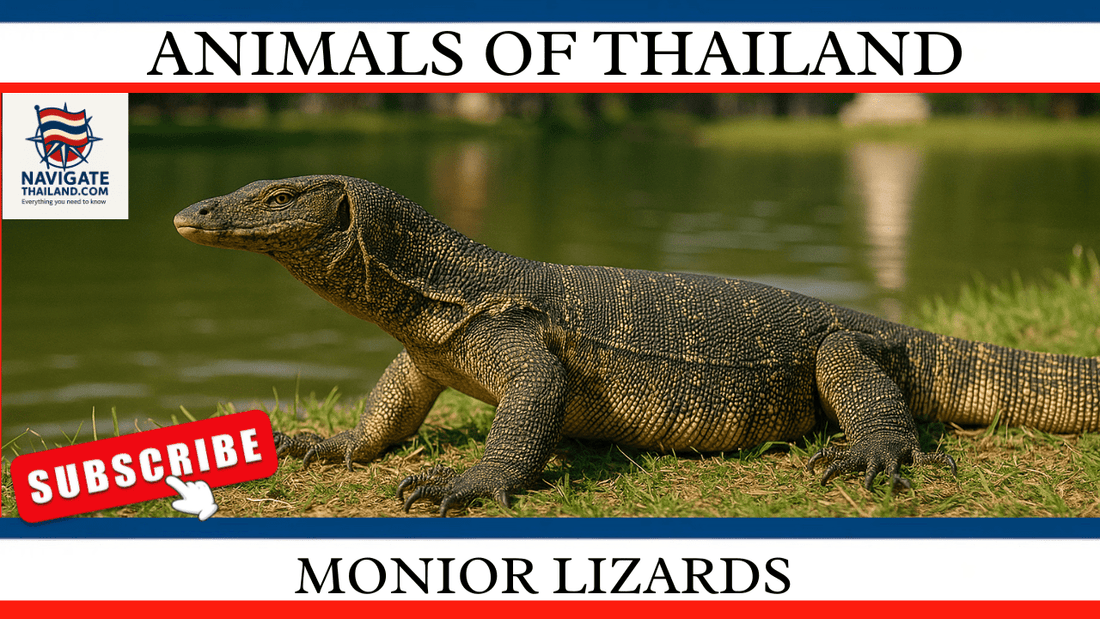
Monitor Lizards in Thailand: Everything You Need to Know
Share
Thailand is known for its rich biodiversity, from its lush jungles to its exotic wildlife. Among the country’s most fascinating creatures is the monitor lizard, a large and often misunderstood reptile that can be found in various habitats throughout the country. For many travellers, the sight of these impressive creatures might be unexpected, especially in urban areas like Bangkok.
Monitor lizards, though imposing in appearance, are an essential part of Thailand’s ecosystems and play crucial roles in maintaining the balance of nature. In this article, we’ll explore everything you need to know about monitor lizards in Thailand, from their biology and behaviour to the best places to see them, fun facts, and how they’ve become a part of urban life.
What is a Monitor Lizard?
Monitor lizards belong to the family Varanidae and are a group of large reptiles that are native to Africa, Asia, and Oceania. They are known for their long necks, powerful limbs, strong tails, and sharp claws. Their most striking feature, however, is their forked tongue, which they use similarly to snakes to detect scents and locate prey.
• Size: Depending on the species, monitor lizards can range in size from 20 centimetres (8 inches) to a whopping 3 metres (10 feet). The water monitor lizard (Varanus salvator), which is common in Thailand, can grow up to 2.5 metres (8 feet) in length and weigh around 25 kilograms (55 pounds).
• Appearance: Monitor lizards are often mistaken for crocodiles due to their reptilian look. They have strong, muscular bodies, with long tails that help them swim, climb, and defend themselves. Their skin is covered in tough, leathery scales, usually dark brown or black, with lighter patterns that help them blend into their surroundings.
• Lifespan: In the wild, monitor lizards can live for about 10-15 years, while in captivity, they can live up to 20 years with proper care.
Fun Fact: Monitor lizards are one of the few reptiles capable of running on two legs for short bursts. This is known as bipedalism, and they use it to escape predators or chase down prey.
Types of Monitor Lizards in Thailand
Thailand is home to several species of monitor lizards, but the most commonly encountered are the water monitor and the clouded monitor.
Water Monitor (Varanus salvator)
The water monitor is one of the largest lizards in the world and is commonly found throughout Thailand. Despite their intimidating size, these lizards are generally shy and avoid human contact. They are most often found near water sources such as rivers, lakes, swamps, and canals, where they hunt for fish, small mammals, birds, and carrion.
• Habitat: Water monitors are highly adaptable and can thrive in a wide variety of environments, from dense jungles to urban areas. In cities like Bangkok, they are often seen swimming in the canals or wandering through parks like Lumphini Park, where they have become something of a local curiosity.
• Diet: Water monitors are opportunistic feeders, consuming anything from fish and crustaceans to eggs, small mammals, and carrion. In urban areas, they are known to scavenge for food, sometimes even raiding rubbish bins or feeding on roadkill.
Clouded Monitor (Varanus bengalensis nebulosus)
The clouded monitor is a smaller, more elusive species found in the forests of Thailand. Though they are less commonly spotted than their water-loving cousins, clouded monitors are skilled climbers and are often found high up in trees, where they hunt for birds, eggs, and small mammals.
• Habitat: Clouded monitors prefer dry, forested areas and are excellent climbers, often seen scaling tree trunks in search of food.
• Diet: Their diet is similar to that of the water monitor, though they tend to focus more on tree-dwelling animals like birds and eggs.
Fun Fact: Monitor lizards are highly intelligent reptiles and are capable of problem-solving. Studies have shown that they can remember locations and even count small numbers of objects!
Monitor Lizards in Urban Areas
One of the most fascinating aspects of monitor lizards in Thailand is their presence in urban areas, particularly in Bangkok. The city’s extensive canal system and large parks provide the perfect habitat for water monitors, which have adapted remarkably well to urban life.
Bangkok’s Lumphini Park is one of the most well-known places to spot water monitors. These giant lizards can often be seen basking on the grassy banks of the park’s lakes or swimming gracefully through the water. Tourists and locals alike are often surprised to see such large reptiles in the middle of the bustling city.
Despite their size and fearsome appearance, monitor lizards in Bangkok are relatively harmless to humans. They are shy and tend to avoid confrontation, though it’s wise to keep a respectful distance, as they can deliver a painful bite if threatened.
Fun Fact: In Thai folklore, monitor lizards were once considered bad omens. Today, however, attitudes have changed, and they are seen more as a part of the natural urban landscape.
Behaviour and Lifestyle of Monitor Lizards
Monitor lizards are diurnal, meaning they are active during the day and rest at night. They are solitary animals and are highly territorial. In the wild, they can cover vast areas in search of food, and some have been known to travel several kilometres in a single day.
Communication and Hunting
Monitor lizards are silent hunters, relying on their excellent sense of smell and vision to locate prey. Their forked tongue allows them to “taste” the air, much like snakes, by picking up scent particles and transferring them to the Jacobson’s organ in the roof of their mouths.
They are ambush predators, waiting patiently for the right moment to strike. Once they capture their prey, they use their sharp teeth and powerful jaws to tear it apart. They have been known to swallow smaller prey whole.
Reproduction
Monitor lizards lay eggs, and depending on the species, females can lay anywhere from 10 to 30 eggs at a time. They dig holes in the ground or use termite mounds to lay their eggs, which incubate for several months before hatching. Once hatched, the young are independent and must fend for themselves.
Fun Fact: Monitor lizards are known to “play dead” when threatened. They will lie motionless and appear lifeless, hoping their predator loses interest.
Ecological Importance of Monitor Lizards
Monitor lizards play an essential role in the ecosystems they inhabit. As both predators and scavengers, they help to control populations of small animals and clean up carrion, preventing the spread of disease.
In Thailand, monitor lizards are considered keystone species in many ecosystems. Their presence helps to maintain the balance between prey and predator populations, and their scavenging habits contribute to a cleaner environment. In urban areas, they are vital in controlling rodent populations, which helps prevent the spread of diseases.
Are Monitor Lizards Dangerous?
Despite their large size and fearsome appearance, monitor lizards are generally not dangerous to humans. They are shy creatures that will usually flee at the first sign of danger. However, if cornered or threatened, they can become aggressive and may defend themselves by whipping their strong tails, biting, or using their sharp claws.
Monitor lizard bites are painful and can lead to infection due to the bacteria in their mouths, but they are not venomous. The best course of action when encountering a monitor lizard is to maintain a safe distance and avoid trying to handle or corner the animal.
Fun Fact: Some species of monitor lizards, like the Komodo dragon, have venomous saliva. However, the monitor lizards found in Thailand do not possess venom.
Monitor Lizards and Thai Culture
Historically, monitor lizards have held a somewhat negative reputation in Thai culture. In the past, they were seen as symbols of bad luck, and the Thai name for the monitor lizard, hia, was used as an insult. Over time, these negative connotations have faded, and today, monitor lizards are more often regarded with fascination and curiosity.
In rural areas, monitor lizards are sometimes hunted for their meat, which is considered a delicacy in certain parts of Thailand. The lizards’ skins are also used to make leather products, though this practice is less common today due to conservation efforts.
Fun Fact: In Thai language, the word hia is a common slang term used as an insult. However, because of this, some Thai people now refer to monitor lizards as “Tua Ngern Tua Thong,” which means “silver and gold creatures” in an effort to avoid the negative connotation.
Conservation Status
The conservation status of monitor lizards varies by species. The water monitor, which is common in Thailand, is not currently considered endangered, and their population remains stable in much of Southeast Asia. However, habitat loss, urbanisation, and poaching pose threats to certain populations.
In urban areas like Bangkok, there are ongoing discussions about how to manage the large monitor lizard populations, particularly in public spaces like parks. While some view them as pests, others recognise their ecological importance and argue for their protection.
Internationally, the trade of monitor lizard skins and meat is regulated under CITES (Convention on International Trade in Endangered Species) to prevent over-exploitation. Efforts are being made to balance human development with the need to conserve these remarkable reptiles.
Where Can Travellers See Monitor Lizards in Thailand?
If you’re interested in seeing monitor lizards during your trip to Thailand, there are several places where you can find them in their natural habitat or in urban settings.
1. Lumphini Park (Bangkok)
Lumphini Park is one of the best-known spots to see water monitors in Bangkok. These reptiles are common in the park’s lakes and canals, and it’s not unusual to see them sunbathing along the banks or swimming through the water.
2. Khao Sok National Park
Located in southern Thailand, Khao Sok National Park offers travellers the chance to see a variety of wildlife, including monitor lizards. The park’s dense forests and rivers provide the perfect habitat for these reptiles.
3. Phang Nga Bay
Known for its stunning limestone cliffs and islands, Phang Nga Bay is another excellent location for spotting water monitors. The mangroves and coastal areas offer the ideal environment for these semi-aquatic creatures.
Conclusion
Monitor lizards are some of the most fascinating creatures you can encounter in Thailand. Whether you spot them basking in the sun at Lumphini Park or catch a glimpse of one in the wild, these reptiles are an integral part of Thailand’s wildlife. While their size and appearance can be intimidating, they are generally shy and pose little threat to humans. They play a vital role in maintaining ecological balance, both in urban environments and natural ecosystems.
If you’re travelling to Thailand, make sure to keep an eye out for these amazing creatures, and don’t forget to respect their space. Whether you’re exploring the jungles or strolling through Bangkok’s parks, encountering a monitor lizard is an unforgettable experience that adds a unique touch to your adventure in Thailand.
Share your thoughts or monitor lizard encounters in the comments below, and don’t forget to share this blog on your social media! If you’d like to learn more about Thailand’s incredible wildlife, subscribe to our YouTube channel where we post videos based on our blogs. Like and subscribe to stay updated on the latest content and fascinating facts about Thailand!
References:
Bangkok Post
National Geographic
Tourism Authority of Thailand – https://www.tourismthailand.org
CITES (Convention on International Trade in Endangered Species) – https://www.cites.org
Read more of our Thailand blog series:
Thai Food Guide:Traditional Recipes and Street Eats
Everything Travellers Need to know
Thailand travel ebooks and language guides
Thailand Travel Apparel & Souvenir Gifts
Subscribe to our YouTube channel Navigate Thailand to see our most popular Thailand travel blogs turned into videos:
Navigate Thailand YouTube channel










































































































































